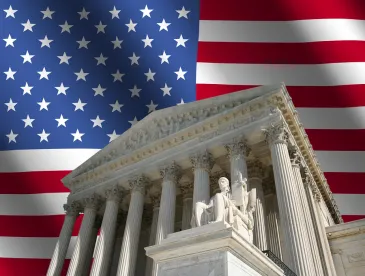On January 22, 2017, the U.S. Supreme Court issued its first 5-4 merits decision of the term in Artis v. District of Columbia. In this opinion, the Court held that bringing state claims in federal court stops the clock on the statute of limitations for those claims.
Under 28 U.S.C. § 1367, federal courts may exercise supplemental jurisdiction over state law claims that arise from the same case or controversy presented in the federal lawsuit. If the federal court later dismisses the federal claims that independently qualify for federal jurisdiction, however, then the court will also ordinarily dismiss the state claims that it had supplemental jurisdiction over as well. As such, 28 U.S.C. § 1367(d) contains a tolling mechanism providing that the “period of limitations for” refiling a dismissed state claim in state court “shall be tolled while the claim is pending [in federal court] and for a period of 30 days after it is dismissed unless State law provides for a longer tolling period.” The Artis opinion dictates how this tolling mechanism operates.
In Artis, the petitioner filed a federal-court suit against the District of Columbia alleging a federal employment-discrimination claim and three related state law claims. At the time of filing, nearly two years remained on the applicable statute of limitations for the state law claims. Two and a half years later, the federal court ruled against Artis on her sole federal claim and dismissed the related state law claims under 28 U.S.C. § 1367(c). Fifty-nine days after the dismissal, Artis refiled her state-law claims in the D.C. Superior Court, but that court dismissed them as time barred.
On appeal to the D.C. Court of Appeals, Artis argued that the statute of limitations on her state law claims did not yet run because the statute of limitations was suspended, or paused, under 28 U.S.C. § 1367(d), while the federal suit was pending. Artis argued that plaintiffs enjoy an additional 30 days on top of the remaining limitations period when the federal suit is dismissed. On the other hand, the City countered that in the context of the 28 U.S.C. § 1367 statutory language, purpose, and history, the word “tolled” meant a thirty-day “grace period” would apply if the limitations period for the state based claims expired while the claim was pending in the federal court.
The D.C. Court of Appeals ruled for the City and concluded that the “grace period” approach, as opposed to the “suspension” approach, reflected the legislative history and intent of the statute. The D.C. Court of Appeals adopted the City’s “grace period” construction primarily because it was convinced that, in drafting §1367(d), Congress embraced an American Law Institute recommendation to allow refiling in state court “within 30 days after dismissal.” The D.C. Court of Appeals also concluded that the grace-period approach “better accommodates federalism concerns,” by favoring a narrow interpretation of federal preemption over state law.
The Supreme Court, however, reversed the judgment of the D.C. Court of Appeals. In a 5-4 opinion, the Supreme Court ruled that the statute of limitations for state claims is suspended while those claims are pending in federal court.
The Supreme Court began by observing that the word “tolled,” in the context of a time prescription like § 1367(d), ordinarily means that the limitations period is suspended (stops running) while the claim is pending elsewhere and then starts running again when the tolling period ends, picking up where it left off. The Court recognized that some statutes do elect to provide a grace period. But the Court noted that, when the grace period mode is adopted, the statute of limitations continues to run while the claim is pending in another forum but then the statutes provide a fixed period in which to refile. The Court found it to be telling, however, that none of the federal statutes that used the grace period approach used the word “tolled’ or any similarly-rooted word. Indeed, the Supreme Court noted that the dissent could not identify one federal statute that used the word “tolled” to mean something other than “suspended,” or “paused,” or “stopped.”
Having concluded that the text-based arguments favored the “suspension” approach, the Court next turned to the constitutional issue of whether its interpretation of 28 U.S.C. § 1367 would cause the statute to exceed Congress’s authority because it would cause too great of an incursion on the State’s domain. In this regard, the Court cited to its earlier opinion in Jinks v. Richland Cty., S.C., in which the Court unanimously rejected an argument that § 1367(d) impermissibly exceeds Congress’ enumerated powers. In Jinks, the Court held that § 1367 was “necessary and proper for carrying into execution Congress’s power [t]o constitute Tribunals inferior to the supreme Court, . . . and to assure that those tribunals may fairly and efficiently exercise [t]he judicial Power of the United States.” Id., at 462.
The dissent, on the other hand, which was authored by Justice Neil Gorsuch and joined by fellow conservative Justices Samuel Alito Jr., Clarence Thomas and Anthony Kennedy, cautioned “the result the court reaches today represents no small intrusion on traditional state functions and no small departure from our foundational principles of federalism.”
Thus, while the question presented was quite narrow and technical, the split is noted to have touched on the broader differences among the justices regarding federalism and the scope of federal power, with the “conservative jurists” seeking to maintain the primacy of state statutes of limitations regardless of federal court filings.



 />i
/>i

